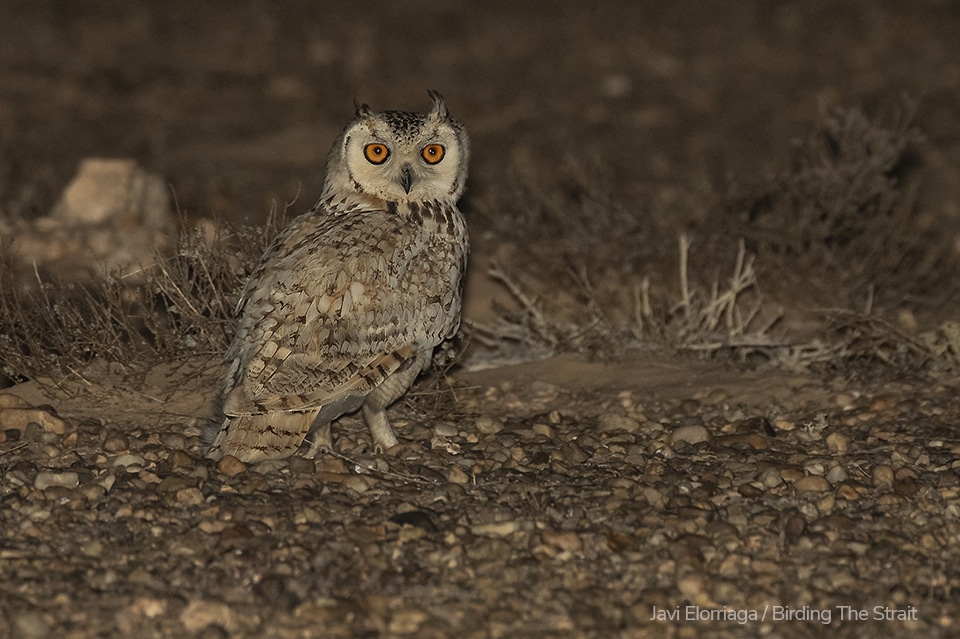
Between the 14th and the 20th of February we ran our second back-to-back tour to the Western Sahara in 2020. This time, it was a private tour for two clients. Following our success in 2019, our main target was to observe the rare Sand Cat. This way, we arranged the logistics and the itinerary to explore remote regions and optimize the effort spent in nocturnal spotlighting. For a change, this was not a birding trip!
We did find the cat! Moreover, we came upon some other totally unexpected highlights, including the very elusive Honey Badger!
In this post we summarize the itinerary, logistics and the wildlife highlights of the trip, including a selection of pictures.
Itinerary: In search of the Sand Cat
As usual, the tour started in Dakhla. Following the late arrival of the clients in a flight from England via Casablanca on the 13th, on the 14th we had an easy start. We departed from the hotel in Dakhla after lunch and took the road to Aousserd. Halfway to Aousserd, we set our desert campsite. We spent two nights here and conducted two spotlighting sessions, including the Bougouffa Trail.
On day 3 we moved to Aousserd. Here we spent the following two nights. We carried out two further spotlighting sessions off-roading in Laglat, Derraman and Oued Jenna. In addition, we spotlighted along the Aousserd-Dakhla road.
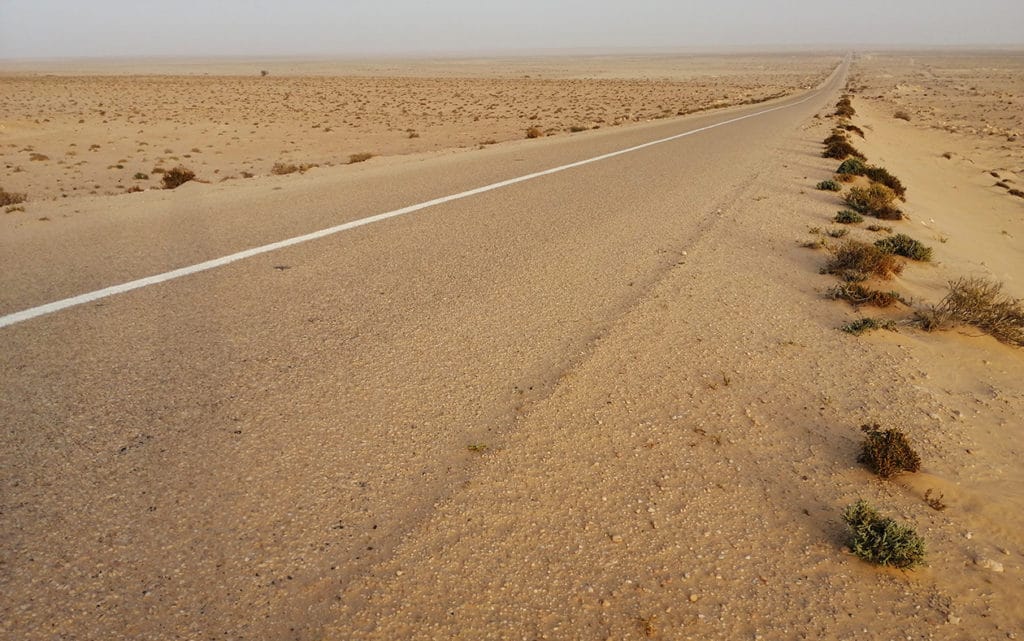
On Day 5 we drove back to Dakhla at an easy pace. This included stops at Oued Jenna and Gleib Jeidane. The Bay of Dakhla made our base for the last two nights. We carried out the last spotlighting session along the Bir-Anzarane road. On Day 6 we relaxed and birded around the hotel. In the afternoon we sailed off the bay.
The trip ended on day 7, with an early morning flight to England and Spain via Casablanca.
In total, we drove about 1400km, approximately one quarter of them off-roading. We invested around 25 hours in nocturnal spotlighting.
Logistics: Western Sahara
We hired the services of a local team including: two expert local guides and drivers, a camp keeper and a cook.
Accommodation
During the three nights we spent in Dakhla we stayed at Dakhla Attitude Hotel. This resort, oriented to water sports, is placed in the northern limit of the bay. It offers great views of the inner bay and good birding possibilities, when not packed with kite surfers. Moreover, its gardens create an oasis effect attracting migrant and wintering birds. In our first visit to the area in 2016 we already highlighted the potential of the resort to attract birds in a desert context. Remarkably, in February 2017 the second White-throated Bee-eater for the Western Paleartic was found here. During our stay in 2020 we found two Olive-backed Pipits !
We set a desert camp in a forest oued, half-way between Dakhla and Aousserd. This way, we minimized the driving distance to some of the spotlighting hotspots. We used portable and spacious Saharawi “Khaima” tents.
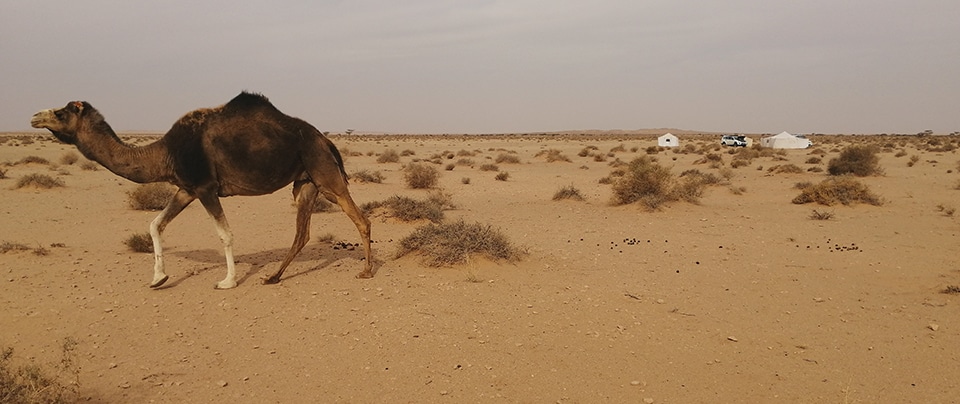
While in Aousserd, we stayed at a private home. This was a basic but very convenient building, entirely at our disposal. Here we had access to electricity, hot water, toilets, kitchen and private rooms.
Transport
We used two 4×4 vehicles. Both were fully equipped with spotlights, water and petrol reservoirs, and all the necessary gear to explore the desert.
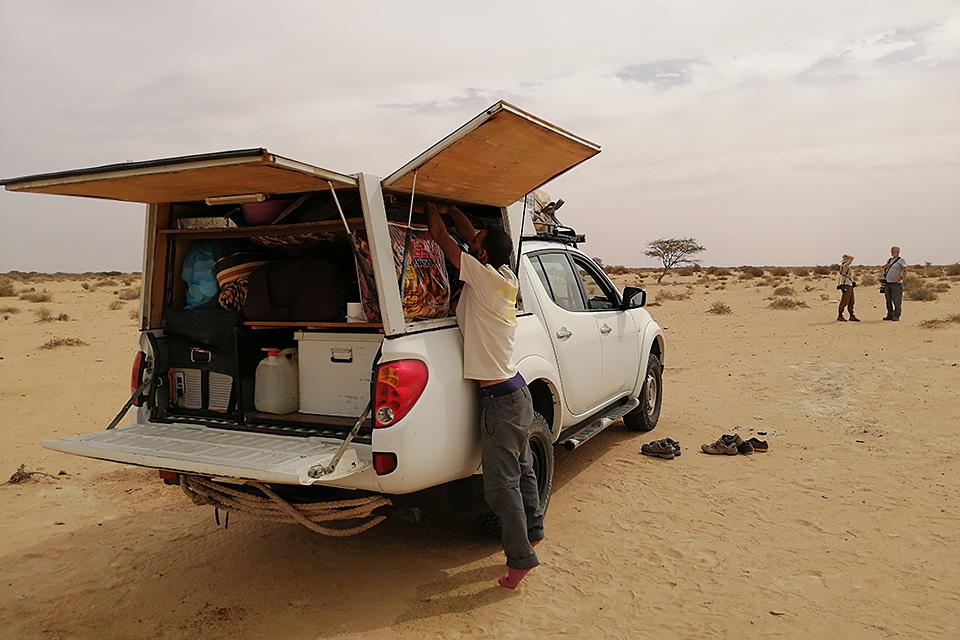
For sailing off the bay, we hired a private three hours excursion in a catamaran with a local company.
Sand Cat, Honey Badger and more
Day one
Halfway between Dakhla and the desert camp, we visited the famous water tank of Tachektent (Aka Gleib Jeidanne). We easily found our two main targets: the African Green Toad and the Mediterranean Chameleon. The first is the only amphibian in the region. The second reaches here the southernmost limit of its range. The reptile was probably profiting from the large concentration of Vagrant Emperors perched on the Tamarisks.
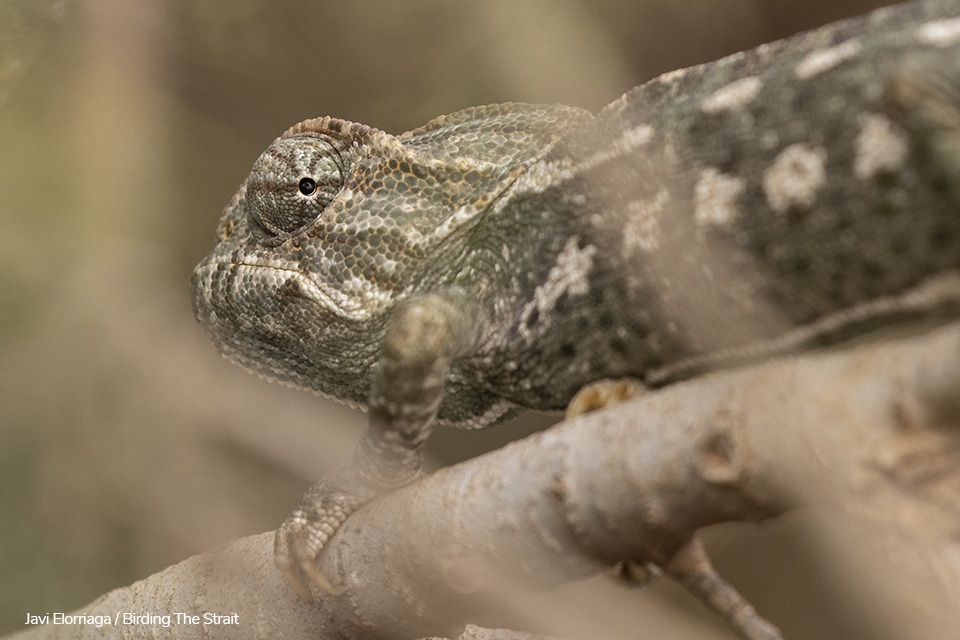
In our first spotlighting session we explored the Bougouffa Trail off-road. We found up to eight Maghreb Hares and numerous Lesser Egyptian Gerboas and Lesser Egyptian Gerbils. We also got the first Fennec of the trip. After this, we headed to an area with scattered Acacias. In some of the trees we came through an unexpected group of 50+ Black Kites gathering in a communal roost. These were birds in northbound migration to their European breeding grounds.
The African Wild Cat
Suddenly, the beam of our torches unveiled the presence of a mammal partially hidden at the base of an Acacia. Luckily, it walked calmly and we could reliably identify it as an African Wild Cat. Indeed, the cheetah-fashion walk is characteristic of the species. It rapidly disappeared. We, therefore, got off the cars and inspected the surroundings on foot. Luckily, we relocated it thanks to the glow of its eyes. It was hidden, immobile, lying on the sand under a bush. We steadily approached it. Amazingly, the cat kept immobile, relying on it camouflage skills. For over 15 minutes we enjoyed the scene, until it just decided to disappear in the darkness.
It wasn´t the Sand Cat, but at this point, we knew we had experienced one of the greatest moments of the trip.
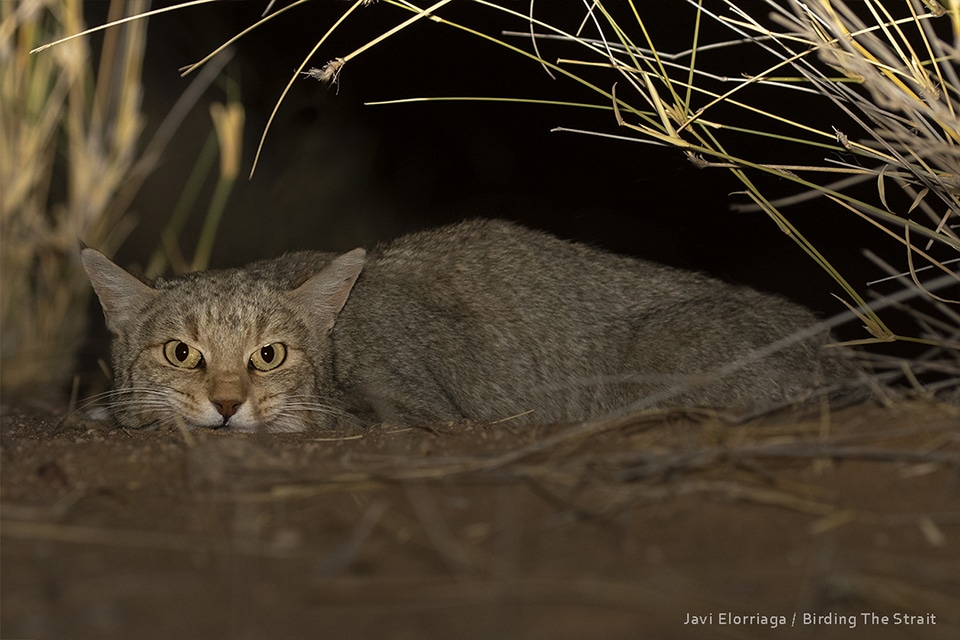
Probably prompted by the warm temperatures and calm wind, at a certain point of the night, hundreds of moths approached our spotlights. We suffered a real invasion!
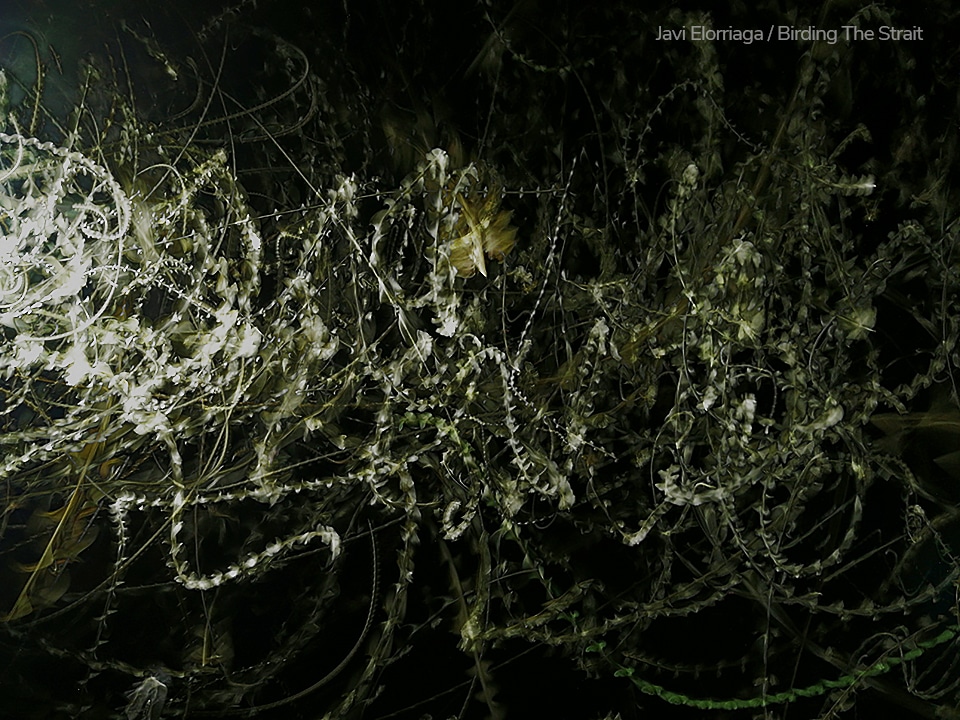
On our way back to the camp we found a Rüppell´s Fox and a Fat-tailed Gerbil, along with more Maghreb Hares and Lesser Egyptian Gerboas.
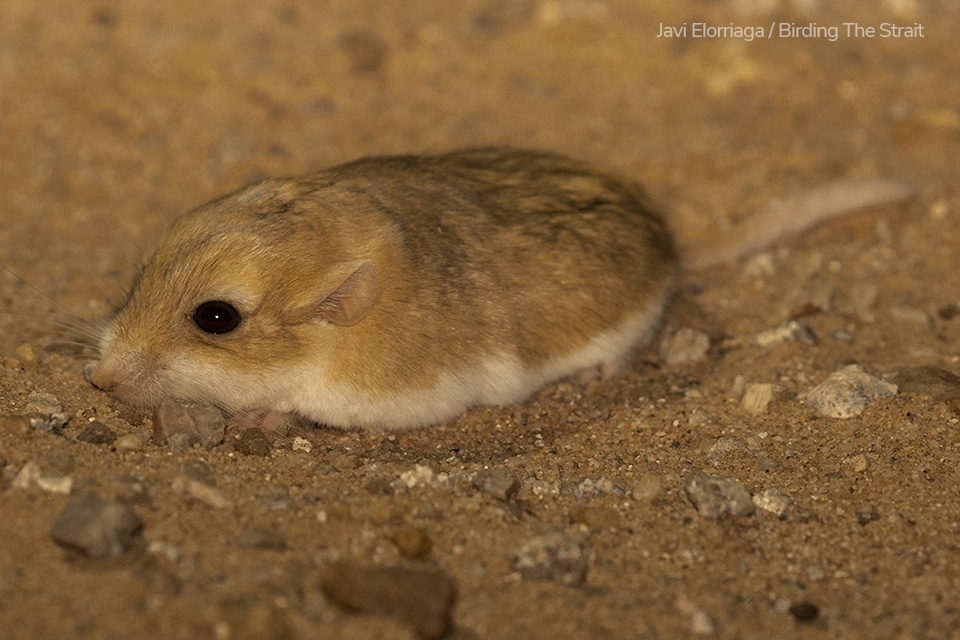
Day two
During the day, we cached up with sleep and relaxed around the camp. Bird activity was rather slow. However, we got decent views of: two Lanners, a group of Fulvous Babblers, Greater Hoopoe Larks, Cream-coloured Coursers, Spectacled Warblers , Desert Wheatears, Bar-tailed Lark and the inquisitive Desert Grey Shrikes.
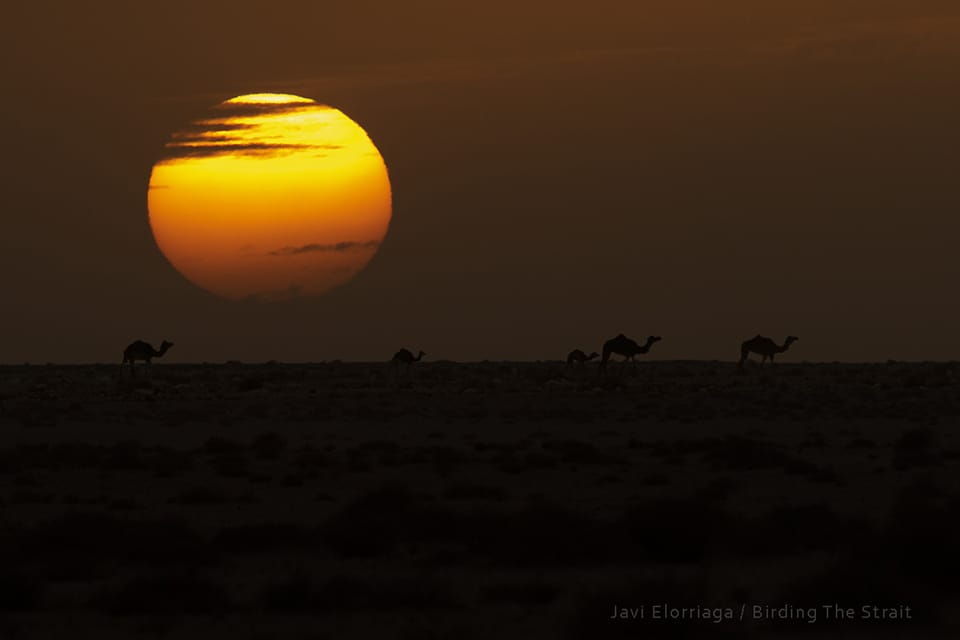
In the second spotlighting session of the trip we explored the surrounding of the camp. We patrolled off-road the ecotone between sand dunes and a the forested oued. Next, we spotlighted along the road. The night turned out comparatively shorter and less productive. As usual, the first mammals we found were Maghreb Hares and Lesser Egyptian Gerboas. Furthermore, we found a Long-legged Buzzard and yet another group of Black Kites roosting atop the Acacias. Once in the asphalt, we found a Fennec sheltering in a shallow depression in the sand. We thought that this particular individual showed especially pale coat.
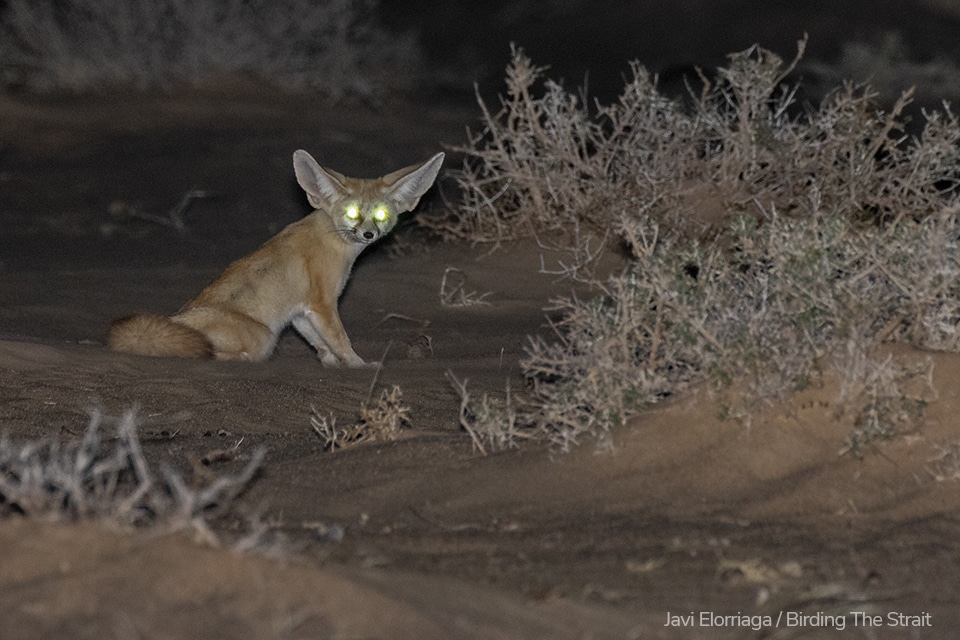
We found no signs of cats, except for some distant glimpses of suspicious unidentified signing eyes…
Back in the camp we found a rather impressive Arrowbreasted Scorpion. We were pleased with this finding, except for the fact that it was right next to our tents!
Day three
As usual in this trip, we had an easy first half of the day. Hanging around the camp site, we found all the usual species we had in previous days. A White-spotted Wall-Gecko was a new find here. After lunch, we left the camp and headed towards our next base in Aousserd. We reached our accommodation in the early afternoon. We had time to relax before our next nocturnal outing.
In the late afternoon, up to 110 Brown-necked Ravens gathered together in an empty lot next to our home. Despite the effort, we did never get to understand what did attracted them there.

On the third spotlighting session we explored south of the Aousserd road, mostly off-road. We intensively scanned a region with optimal habitat for the Sand Cat: sandy soil with sparse vegetation. Indeed, we knew of recent records in the area. In our quest we found a Pharaoh Eagle Owl on the ground. We watched it in detail through the scope. It was surprising to observe how skilled it was running. A bit further, we came through a Rüppell´s Fox, which we had to follow for a while before we could reliably identify.
The Honey Badger!
Next, we faced a rather long period with no remarkable sightings. However, our perseverance was greatly rewarded when a gorgeous Honey Badger showed up. Right next to us!
It is important to remark here that, over the last decades, there have been only a handful of documented records for the species in the region. Indeed, very little is known about its ecology and distribution north of the Sahara (Cherkaoui and Bouajaja, 2017).
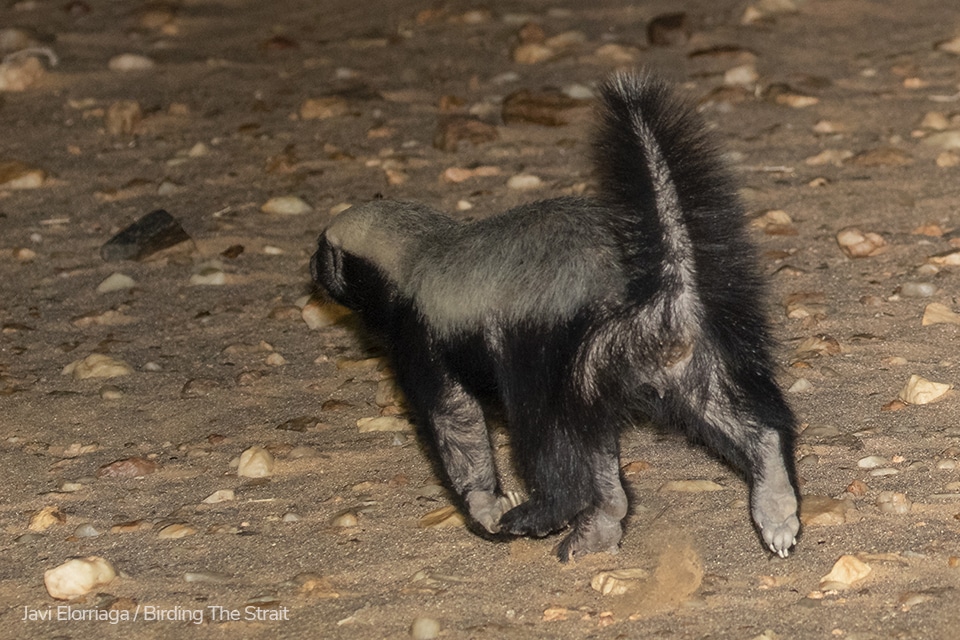
A recent study in Morocco showed that Spiny-tailed Lizards make up to two thirds of its diet. The authors concluded that Honey Badgers behave as a trophic specialist in the Sahara. This is probably thanks to exclusive anatomical adaptations for digging their prey out of their burrows.
It is curious to note that the black and white pattern of the Honey Badger is a warning coloration (also known as aposematic) advertising not only the extreme ferocity of the species, but also its capacity to produce noxious secretions with anal sacs.
We kept track of the badger for about 10 intense minutes before it disappeared in the vast plains.
To our knowledge, the ones we got are the only available pictures of a wild Honey Badger alive in the Maghreb region, except for those got by means of camera-trapping.
Back in the asphalt road, already in our way back to Aousserd, we got yet another rewarding encounter. This was about nothing less than a much-anticipated Horned Viper.
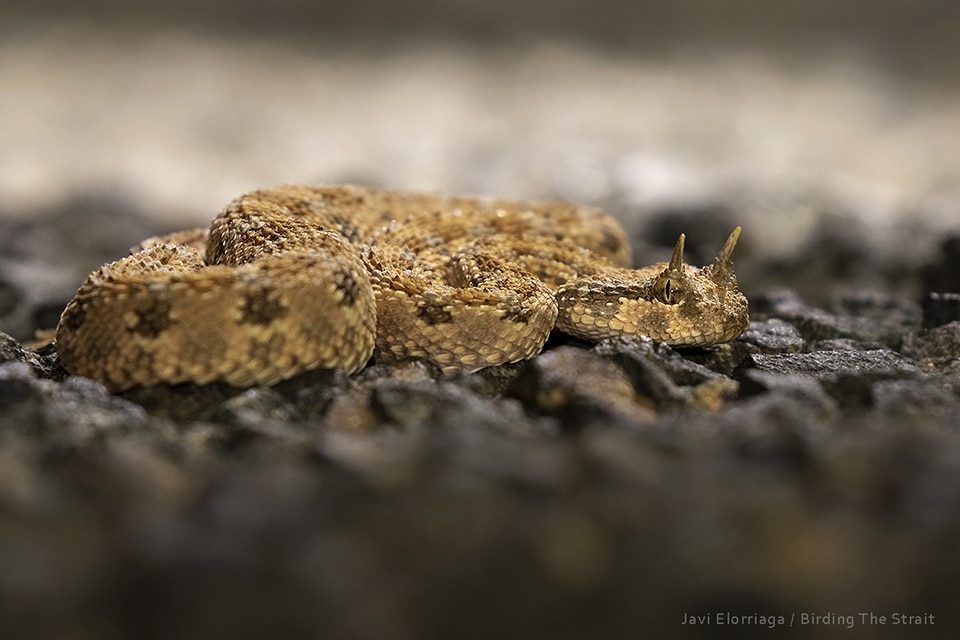
After an exciting photography session, we retrieved the snake from the road and resumed our way back home, where we reached shortly before 4 AM.
Day four
In our second day in Aousserd, we accidentally found a colony of Lesser Mouse-tailed Bats within an abandoned building. We counted over 50 individuals. However, we didn’t inspect other occupied rooms in order to avoid disturbance.
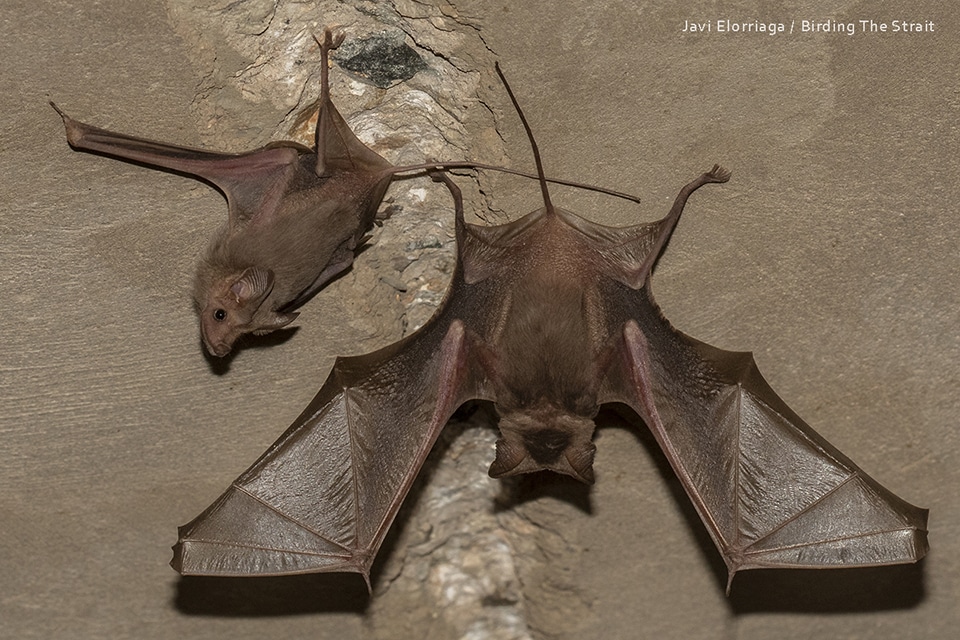
Every now and them, we saw small groups of Black Kites in active northbound migration over the village. A White-crowned Wheatear and a pair of Desert Sparrows visiting the window of our living room was great joy too.
Today we had an early supper consisting of a Harira soup, a Moroccan speciality.
We left Aousserd in the late afternoon and reached Derraman area well before sunset. Here, we were welcomed by a pair or Lanners. These offered a nice display, both in flight and perched. Several Pale Rock Martins flew by along the cliffs.
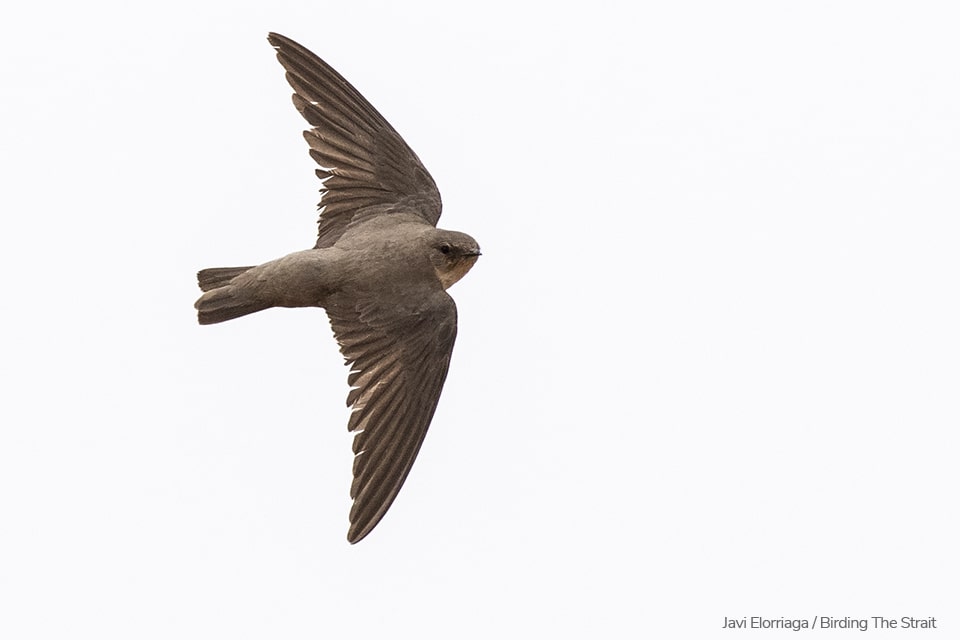
We strolled around enjoying a magnificent scenery with black rock outcrops emerging from the dunes in a vast unspoiled pre-Sahelian landscape. Remarkably, the Western Sahara is one of the most sparsely populated regions of the planet.
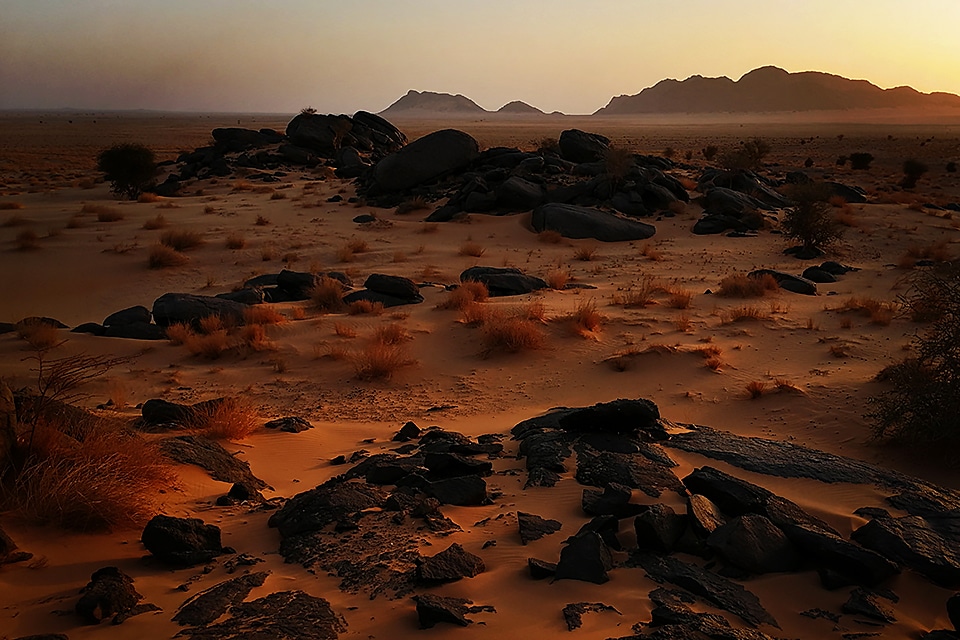
After sunset, we continued for our fourth spotlighting session. First, we explored the Derraman area where we spotted a Rüppell´s Fox and several, Hares, Gerboas and Gerbils. In this rocky area, we found a remarkable density of Geckos. This included Petrier´s Sand Gecko and White-spotted Wall Gecko. Back in the asphalt we came through a Diadem Sand Snake.
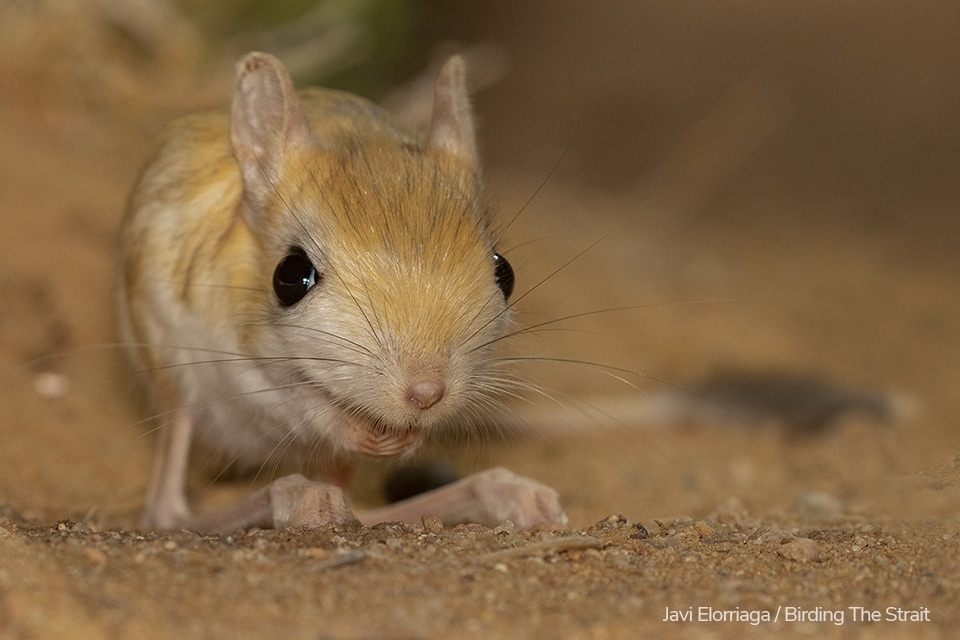
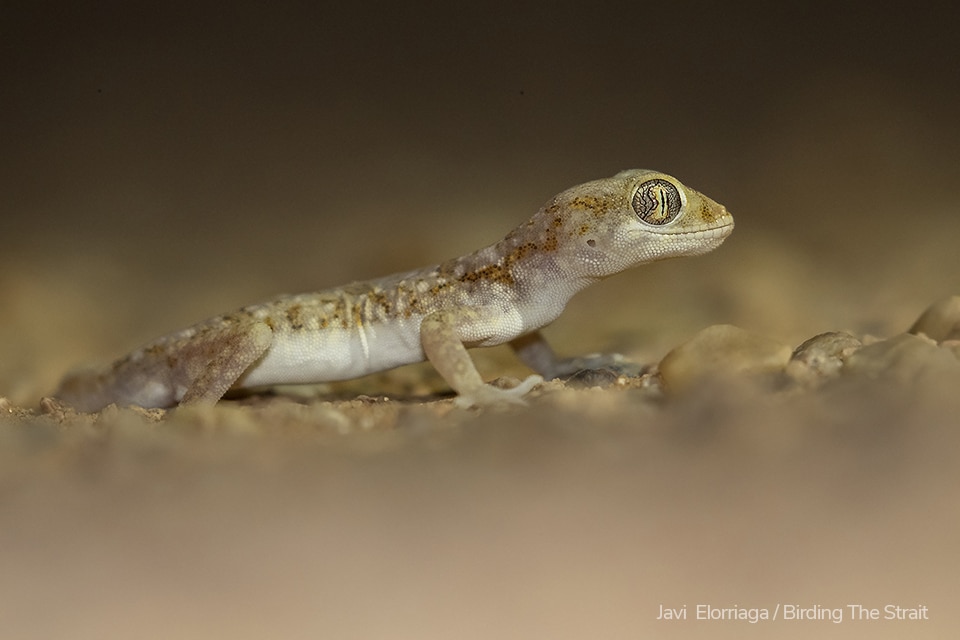
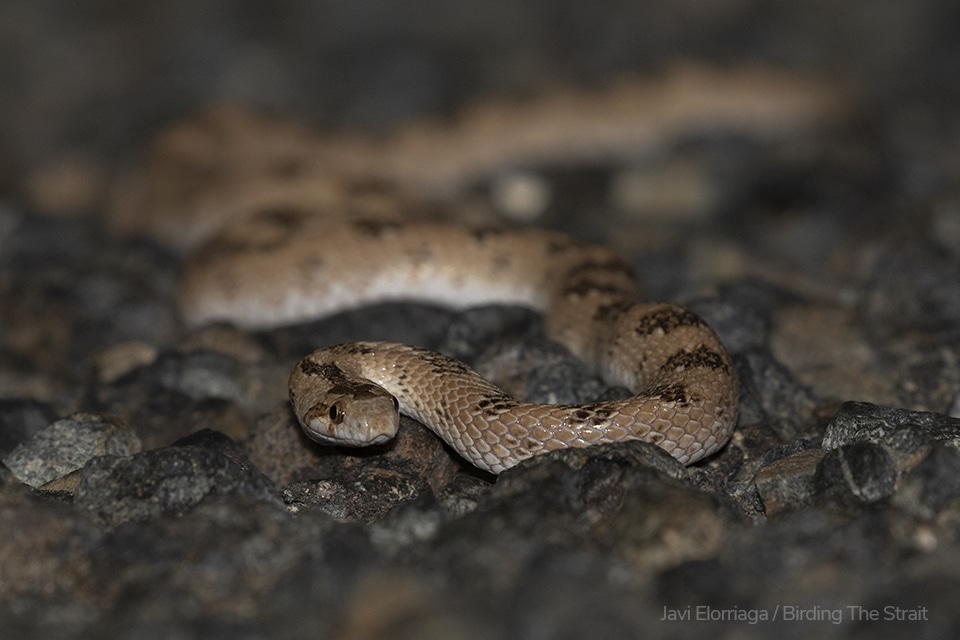
Day five
Today we left Aousserd to return to Dakhla. In the outskirts of Aousserd we found abundant Sudan Spiny-tailed Lizards. We spend some time trying to approach and photograph these impressive reptiles. In doing so, a group of Dunn´s Larks joined in the scene.
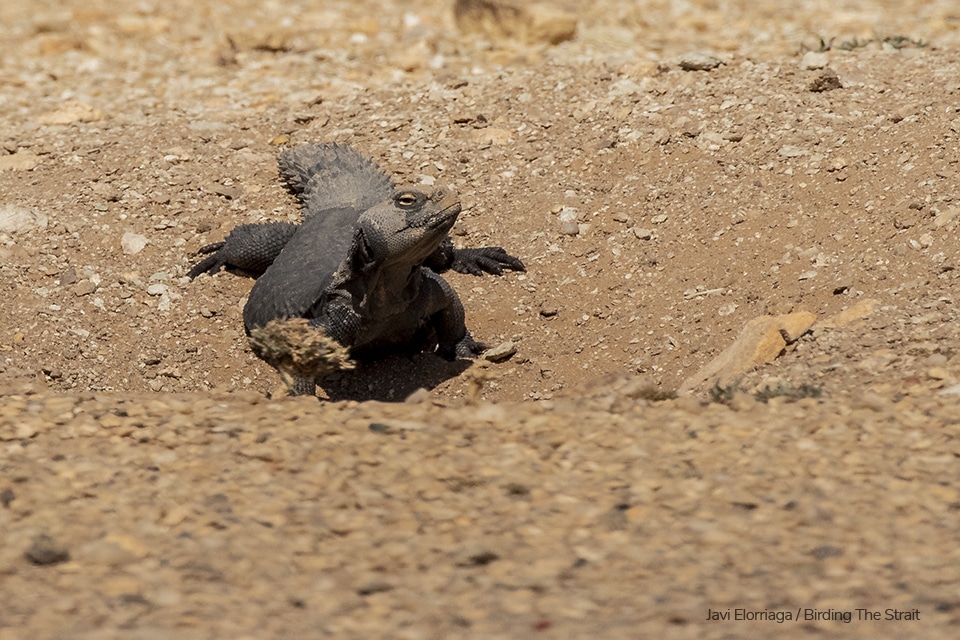
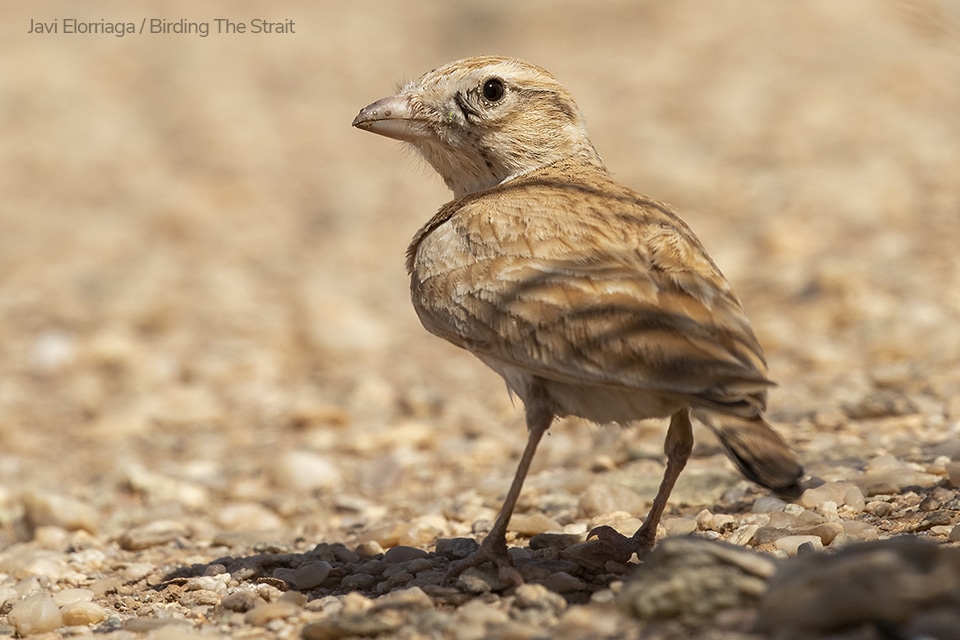
In our next stop, Javi retrieved a camera trap he has been using over the last weeks in the area. Fennec, Rüppell´s Foxand a Camel (!?) where among the most remarkable footage it recorded. This has to be added to the Desert Hedgehog and the African Golden Wolf got on previous weeks. Not bad at all!
Before reaching Dakhla, we revisited Gleib Jeidane. Here we found a Mediterranean Chameleon again. In addition, we spent some time trying to photograph Trumpeter Finches and a Desert Grey Shrike as they approached the water. 45 minutes later we reached our hotel in the bay of Dakhla. We accommodated in our rooms and had some rest before dinner.
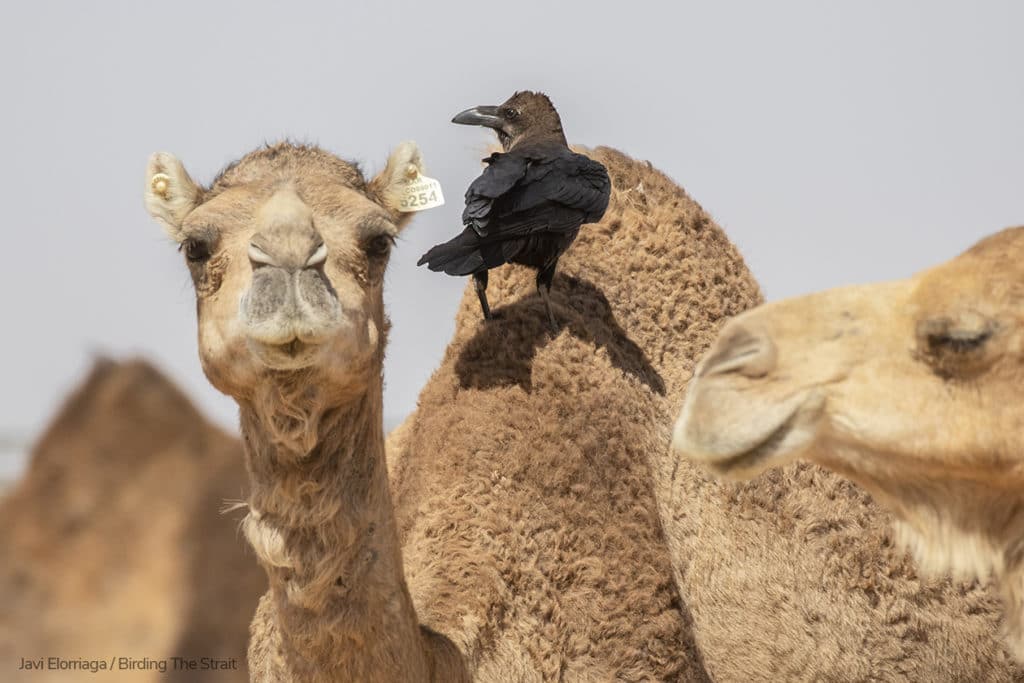
After sunset, we hit the road again towards the nearby Bir Anzaranne road for the last spotlighting session of the trip. Our first stop was by a water hole. Here we found a Rüppell´s Fox drinking. Some 30km later we found a second Rüppell´s. This time it was lying on the ground, sheltered by a bush.
The Sand Cat!
Not far, we detected a suspicious pair of signing eyes. We kept track of it until it showed its whole body. Bingo! there it was, a Sand Cat! We saw it at medium distance (90m approx.). At first, it fixed its gaze on us and stayed immobile. Then, it relaxed and kept foraging. However, it still turned its head towards us from time to time. We got off the vehicle and approached the cat on foot. This way, we got a brief but better view of its short-legged structure and ringed tail-tip. After a few minutes of observation, the Sand Cat walked away to disappear behind the slope.
Well, we couldn´t get any pictures, but there it was! After many hours of intense nocturnal search, we got convincing views of the elusive creature!
Having delivered the corresponding congratulations, we resumed our way. Amazingly, a few kilometres after we connected with a second Sand Cat, which offered a similar show!
Gratified with our Sand Cat in the pocket, we decided to call it a day and drive back to the hotel, shortly after midnight.
Day six
During the morning we relaxed around the hotel. Surprisingly, Javi found not one but two Olive-backed Pipits right at the doorstep of his bungalow! According to the existing information, this was only the third record in the Western Sahara. The Siberian Vagrants did totally eclipse the presence of abundant Black Wheatears, Painted Ladies and Vagrant Emperors.
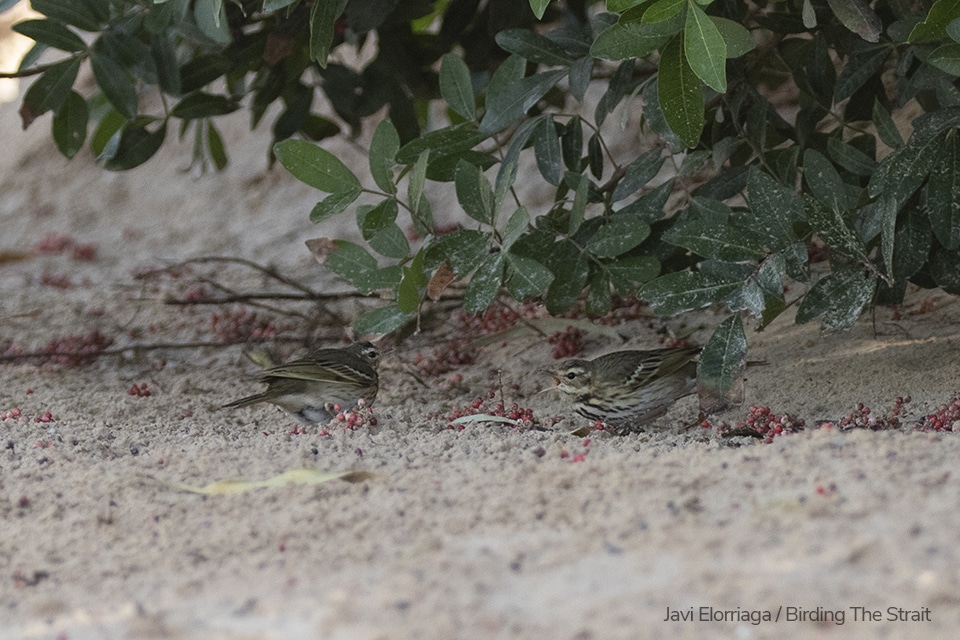
Sailing off Dakhla
In the afternoon, we went sailing off Dakhla. We organized a 3-hours private sailing excursion to explore the inner part of the bay. Our main target here was the Critically Endangered Atlantic Humpback Dolphins. Nowadays, the bay ofDakhla constitutes the northernmost limit of the species distribution.
Unfortunately, we had a very windy day and choppy sea. This frustrated our chances to find the dolphins. We did, however, enjoy a smooth and most enjoyable sailing.
In terms of birding, we came through some nice species including: a single African Royal Tern, numerous Caspian Terns, Gannets fishing, some big groups of Bar-tailed Godwits, Great Cormorants of the lucidus/marocanus subspecies and one Osprey.
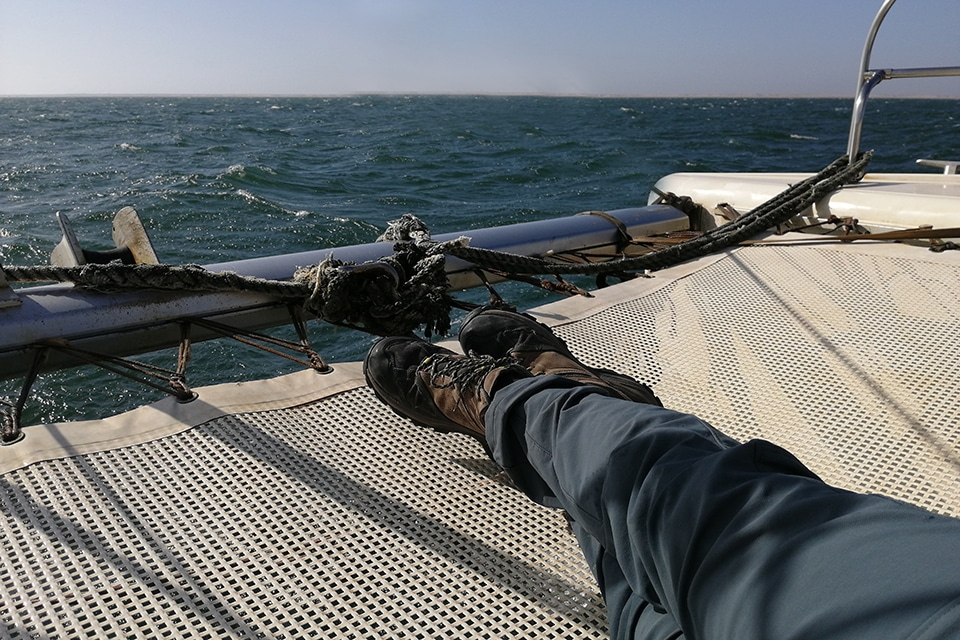
We returned to the hotel in the late afternoon, with time for packing our luggage before dinner. Next morning, we had an early departure from the nearby airport of Dakhla.
Recommended bibliography
There are several recent publications which greatly enhance the knowledge on the Moroccan and Western Sahara wildlife. We have used them and we do eagerly recommend it:
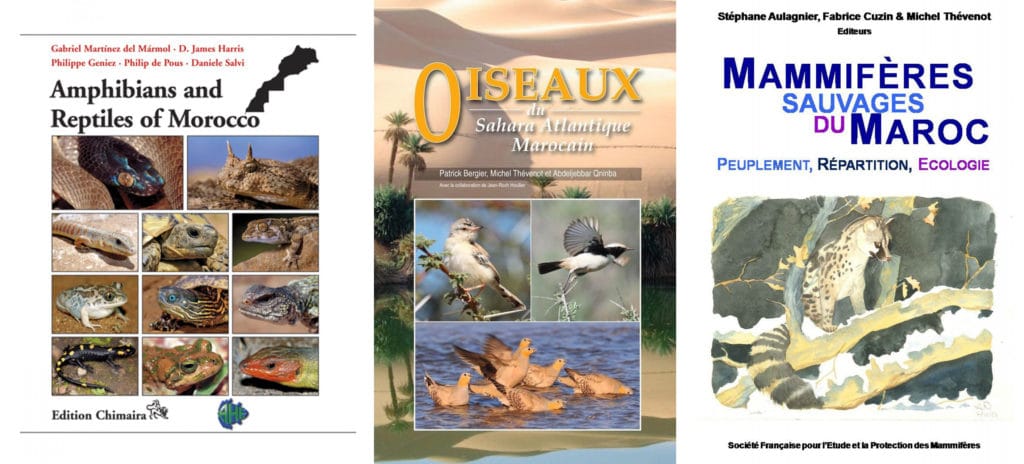
- Amphibians and Reptiles of Morocco. 2019. Martínez del Marmol, et al. Edition Chimaira
- Oiseaux du Sahara Atlantique Marocain. 2017. Bergier, P., Thévenot, M. and Abdeljebbar Qninba.
- Mammiferes Sauvages du Maroc. Peuplement, Repartition, Ecologie. 2017. Aulagnier et al. 2017. Societe Frencaise por Létude et la protection des mammiferes.
Our previous trips to the Western Sahara
Check out the following links to read the trip reports of our previous visits to the Western Sahara. These trips were primarily focused on birding. The reports include a varied selection of photos, including the Sand Cat!
- Birding Trip to the Western Sahara, February 2016 – Trip Report by Yeray Seminario and Javi Elorriaga
- Birding Trip to the Western Sahara, January 2019 – Trip Report by Yeray Seminario and Javi Elorriaga.
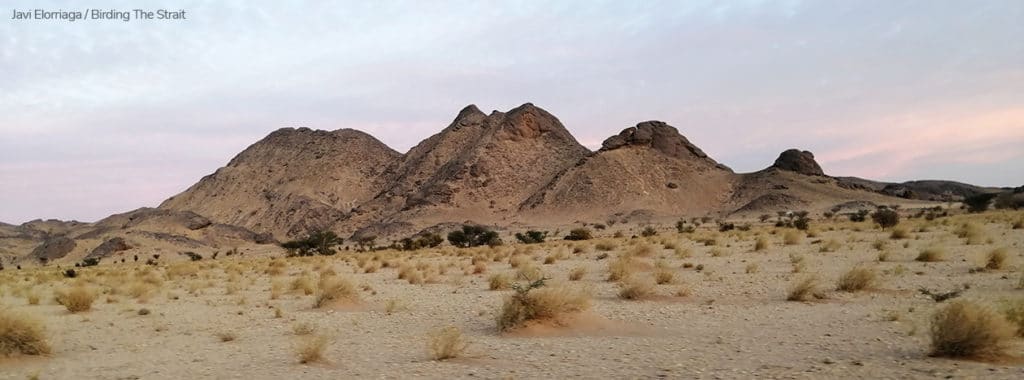
Acknowledgements
We want to express our most sincere gratitude to Martina Milanese and Nicolo Calcagno and their team: Sidi, Amina and Sara. Thanks to them we safely visited remote regions of the Western Sahara and enjoyed its wildlife, including the Sand Cat.